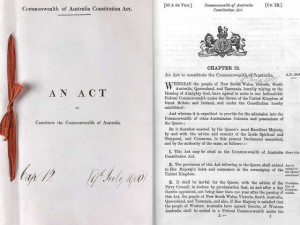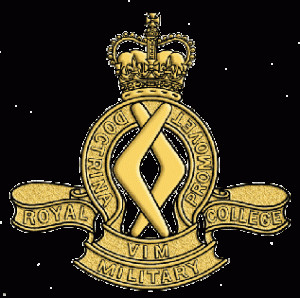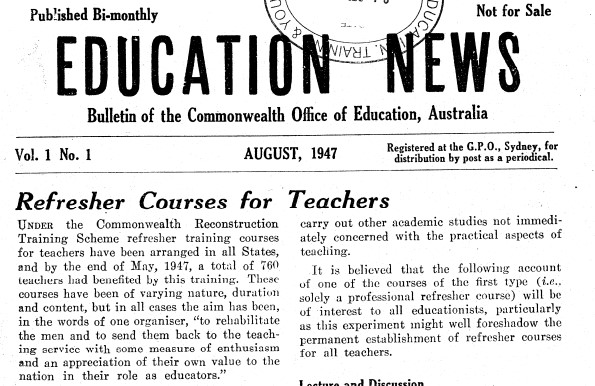On 1 January 1901, the Australian federal constitution came into operation and the Australian nation was born. Among its many tasks, as in all federal constitutions, was the enumeration of powers to be divided between the national or Federal government, and the States of the Commonwealth. The Australian Constitution specified the exclusive powers of the Federal government. There were also concurrent powers over which States and Commonwealth could legislate. Any powers not named in the Constitution, the so-called “residual” powers, belonged to the States.
Responsibility for schools and education was not specified as a power of the Federal government. Constitutionally, responsibility for education belonged to the States. The educational arrangements of each State: New South Wales, Victoria, South Australia, Queensland, Western Australia and Tasmania, continued without interruption from the colonial period, before 1901.

The Constitution of Australia 1901 in which neither schools or education are mentioned.
At the same time, the Commonwealth government assumed full power to legislate for its own territories, including their educational arrangements (Section 122). This explains why some educational institutions such as the Royal Military College (Duntroon), and the Canberra University College (originally affiliated with the University of Melbourne) were established within the Australian Capital Territory.
Despite its restricted role in education, by the late twentieth and early twenty-first centuries, the Federal government was a significant funder of Australian education at all levels: pre-school, primary, secondary, tertiary and youth training more broadly. It developed policy and law concerning education that often had decisive impact. Historically, the Australian Constitution has been difficult to amend, a consequence of which is that Federal governments achieved their substantial power over Australian education by other means.
1901 to 1946
Generally, the Federal government (also referred to in this entry as “the Commonwealth”) and the States adhered to the intentions of the constitutional founders, that the Commonwealth government would not interfere in education. It was the responsibility of the States. Nevertheless, even in this early period, exceptions were made. The participation of Australia in the wars of 1914-1918 and 1939-1945 demanded a national effort that involved certain kinds of education and training, especially to develop military capacity. Later there would be provision for the education of repatriated soldiers. Similarly, research in science and medicine and the education associated with such research could be seen as a national priority, demanding Federal government support.
Interventions occurred (see below) but there was very little desire by the Commonwealth to intervene in public and private schooling. In this period the constitutionally defined separation of powers between Commonwealth and States generally held.
The educational initiatives by the Commonwealth that occurred were justified by powers of the Federal government relating to defence, territories and post and telegraphs for example. Clauses in Sections 51 and 52 of the Constitution were interpreted as authorising the initiatives.
There was also Section 81 of the Constitution that gave the Federal government power to fund projects “for the purposes of the Commonwealth … subject to the charges and liabilities imposed by this Constitution”. Interpretations of this section allowed an expansion of Federal government powers beyond what the founders of the Constitution may have imagined.
Initiatives of the Commonwealth in this early period are listed below. The States, and possibly other education providers, did not usually contest the constitutionality of these initiatives. Their effect was to relieve States of the pressure and cost of providing similar educational services.
Interventions by the Federal government (1901-1946) included:
1906: “Military science” education and training through assistance to the universities of Melbourne and Sydney.
1910: The requirement that Australian schools provide military cadet training for boys.
1911: Royal Military College of Australia (Duntroon).

Badge of the Royal Military College Duntroon. A school founded by the Federal government in 1911.
1919: Vocational training for returned soldiers from World War I.
1919: A professorship in oriental studies at the University of Sydney.
1921: Financial assistance for the post-primary education of the children of killed or seriously wounded soldiers.
1925: A department of anthropology, University of Sydney.
1926: Funding and staffing the Australian Forestry School, University of Adelaide.
1926: Studentships for the CSIR (Council for Scientific and Industrial Research).
1929: Commonwealth School of Public Health and Tropical Medicine, University of Sydney.
1930: University College Canberra with a responsibility that included the training of Commonwealth public servants.
1932: Australian Broadcasting Commission founded, including educational programs for schools from 1934 if not before.

Australian Broadcasting Commission provided national support for school curricula from the 1930s.
1936: CSIR research grants to Australian universities.
1938: Establishment and maintenance of a professorship in aeronautical engineering, University of Sydney.
1938: Lady Gowrie Child Study Centres (preschools) in each State.
1938: Training of teachers and lecturers in physical education (“national fitness” programs).
1939: An associate professorship in meteorology, University of Melbourne.
1942: Grant to ACER (Australian Council for Educational Research) for education research and testing.
1943: Commonwealth Literary Fund to support lectures on Australian literature in all Australian universities.
1946: Foundation of the Australian National University, situated within the Australian Capital Territory.
In 1946 the Constitution was amended to allow Federal government to pay student allowances (Section 51 xxiiiA), putting on a firmer footing some of the federal legislation previously reliant on Section 81.
1947 to 1965
The use of Section 81 by the Federal government for educational initiatives had its difficulties, and a more secure constitutional foundation for Commonwealth initiatives was sought. Section 96 of the Constitution was interpreted to serve the purpose, remaining a fundamental foundation of ambitious Commonwealth policy in many areas, not only education, through to the present day. Section 96 provided that “the Parliament may grant financial assistance to any State on such terms and conditions as the Parliament thinks fit.” In general, and especially since World War II when the Commonwealth government assumed significantly greater powers of taxation in comparison to those of the States, the States have usually accepted such funding for all sorts of purposes, including areas in which they were originally intended to retain sole jurisdiction, such as education.
States may have disagreed with some of the conditions the Federal government required if they were to receive funding, but with reduced taxation powers (and consequently, revenue) the States could usually ill afford to resist the conditions.
An Office of Education was established by the Commonwealth soon after the end of World War II. In 1947 it began publishing a newsletter that encouraged new thinking on educational policy in Australia (see below).

Education News. A Federal government initiative publicising its policies. Extract from vol. 1, no. 1, 1947.
1966 to the 2020s
From the 1970s the High Court interpreted the Constitution to allow a so-called “nationhood power” (Spaull, pp. 110-112). This increased Federal power in several areas, including education. Interpretation of the Constitution is a principal duty of the High Court of Australia. Its tendency, especially during and since World War II, has been to allow an expanded role for the Federal government at the expense of the States.
In 1966 the Commonwealth established its own Department of Education and Science, which under various names and divisions of responsibilities, continues into the 2020s. It, and various Commonwealth commissions, assumed responsibility for administering an increasing number of federal interventions in schools, universities and education and training more generally.
The Menzies government began this process with its new funding of science teaching facilities and school libraries in the 1960s. The Whitlam government (1972-1975) passed legislation establishing the Australian Schools Commission. The Schools Commission initiated more permanent funding of government and nongovernment schools by the Commonwealth. The funding of church-owned, nongovernment schools, was challenged in the High Court. Section 116 disallowing the establishment of religion was held by the Court in its 1981 judgement as not prohibiting Commonwealth assistance to religious/church schools and school systems. Youth training schemes were also established on a national basis in this period.

A massive intervention in Australian higher education under Federal Minister John Dawkins. Source: Book cover, Melbourne University Press
The funding of technical education, colleges of advanced education and universities followed Commonwealth consideration of its Murray (1959), Martin (1964) and Kagan (1974) reports. A further dramatic intervention in tertiary education came with the so-called Dawkins reforms from 1988 during the period of the Hawke-Keating governments. The Commonwealth emerged not only as the most powerful shaper of post-secondary school education but education in general across all sectors.
From the 1980s the Commonwealth also intervened in school curriculum, advocating a National Curriculum, versions of which emerged in cooperation with State governments. The Rudd and Gillard Labor governments introduced a national student testing scheme across all schools (NAPLAN) in 2008.
The Commonwealth government and education
The Australian Education Act (2013, as amended 2020) has a preamble that clearly states the ambitions of the national government in education:
Education is the foundation of a skilled workforce and a creative community. A strong and sustainable schooling system is critical for Australia’s future prosperity. A good education prepares students for full participation in society, both in employment and in civic life. Education also has a role to play in overcoming social and economic disadvantage.
If Australia is to be a prosperous nation with a high standard of living in the 21st Century, our schooling system must provide children with the skills needed to participate fully in a knowledge‑based economy. The performance of Australia’s schools, and school students, must continuously improve; our capacity to innovate, to embrace change and to seize new opportunities will depend more and more on the education and skills of our community.
There is an ongoing and essential role for the Commonwealth in school education through its unique position to provide national policy leadership and facilitate national performance assessment and reporting. Transparency and accountability ensure public confidence in the education system and promote excellence in teaching and school leadership.
The Commonwealth will deliver record and growing levels of investment in schools. To help education authorities provide every child with a quality education, regardless of where they live and what school they attend, this investment will be fairly and transparently distributed and allocated according to need.
In its role as a national policy leader, the Australian Government will work collaboratively with States and Territories to achieve agreed national objectives and priorities for schools through the Council of Australian Governments and the Education Council.
To drive improvement in school outcomes, State and Territory education authorities will be required to deliver evidence‑based reforms in schools.
The Act goes further, asserting its constitutional validity:
This Act provides Commonwealth financial assistance for schools. The financial assistance is provided to States under section 96 of the Constitution, and to Territories under section 122 of the Constitution. The Act imposes requirements on States and Territories as conditions of this financial assistance, including requirements to comply with intergovernmental agreements on school education, and to implement nationally‑agreed policy initiatives on school education.
Despite any intentions that the writers of the Australian Constitution may have had in 1901, the Commonwealth government has become the most significant shaper of Australian national educational activity.
